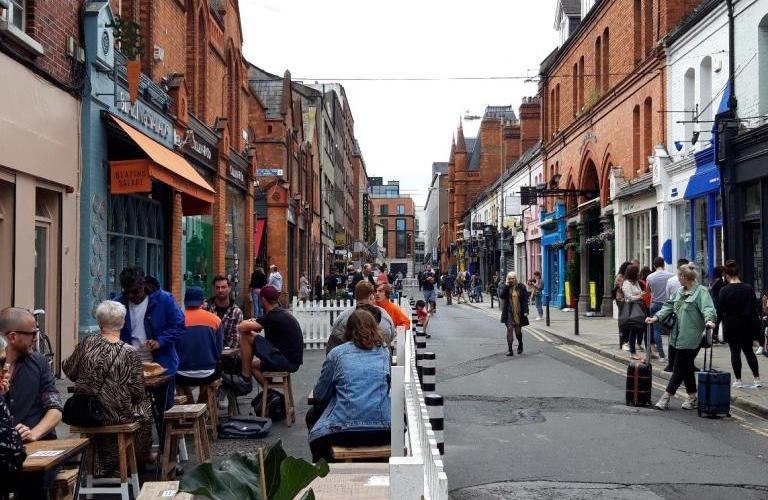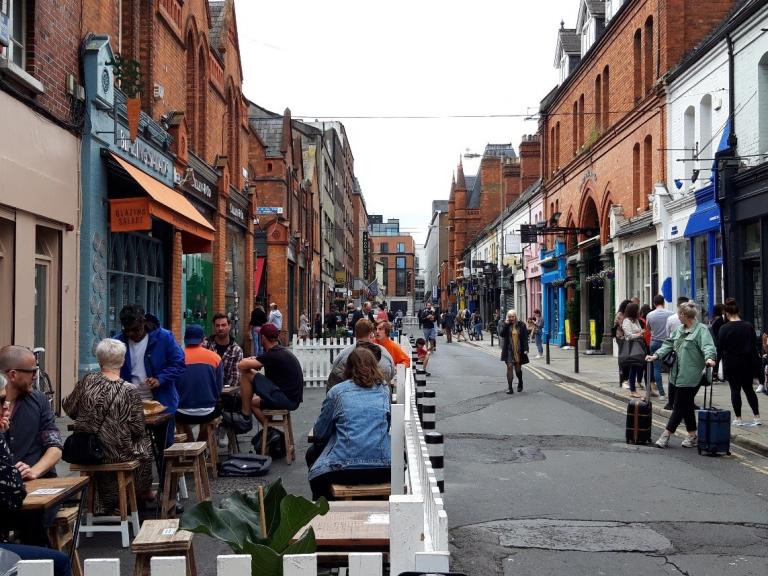Yvonne Lalyre drank her first cup of linden tea in Frankfurt Germany in the spring of 1981.
But it wasn’t until she moved to Greenwich Street in Roxbury five years later that she realized how the medicinal brew was made.
“We have lots of lindens,” said Lalyre, a retired Boston Public School employee originally from Panama. “You can make tea out of the flowers, they have fragrant flowers.”
Lalyre has lived beside Melnea Cass Boulevard for more than 30 years and, of all the trees that line the major traffic route, the 130-foot linden trees are her favorite. “In June you can look around and they are wonderful, it smells so beautiful around here,” said Lalyre.
Zara Zsido moved to Windsor Street, parallel to Melnea Cass Boulevard, in 2009. “These trees are a buffer, a buffer for sounds and a buffer for cooling,” she said. “They make the neighborhood livable.”
They’re not just good for shade, scent and herbal tea. These trees, and the hundreds of others that line the boulevard, help manage noise and pollution.
Roxbury is a heat island, experiencing much higher temperatures during the summer than in leafier, greener parts of Boston. On average 32,000 vehicles use the corridor daily, spewing global-warming gases into the air that help raise the mercury in a largely Black, low-income neighborhood with few natural resources to alleviate soaring temperatures.
“It’s an environmental justice neighborhood,” said David Meshoulam, executive director and co-founder of Speak for the Trees, an organization working to protect trees in city neighborhoods impacted by global warming and climate change. “These trees help mitigate against harm by cleaning and cooling the air, providing respite, and creating a sense of belonging and community.”
Despite these benefits, the City is planning to remove more than 100 mature trees along Melnea Cass in order to reconstruct the corridor, add new bicycle lanes and improve safety, according to plans approved in 2018 which received funding this March.
An out-of-state contractor — Newport Construction — has been chosen for the project and construction is set to start this fall.
But Roxbury residents are fighting back.

“When they approved the contract we thought ‘Oh my god they can come any moment and start cutting the trees,’” said Lalyre. “So we asked [the City] and they didn’t answer and I said ‘Well we’re going to have to start doing something otherwise they’re just going to come and cut the trees without us knowing.’”
Taking action
Four weeks ago, Lalyre wrapped strips of fabric around the at-risk trees. “I put the bands on the trees for people to see,” said Lalyre. “I got my neighbors to give me their old bedsheets and I stripped them.”
Lalyre — who stands at the intersection of Melnea Cass and Tremont Street protesting the City’s plans every Monday, Wednesday and Friday at 8 a.m. and 6 p.m. — and other neighbors are calling for a public hearing on the removal of these trees. They say attempts at community engagement stopped once project funding was secured and the pandemic shutdown has made communication between city officials, planners and residents more difficult.
Besides stand-outs, a petition demanding a public hearing, started by the Friends of Melnea Cass Boulevard Association, has received 4,490 signatures so far.
“Our organizations include local residents concerned about this project and the impact the loss of trees will have on air quality, ambient temperature, and livability in this neighborhood, part of a designated severe heat island in Boston’s Climate Ready Boston Final Report from 2016,” says the petition.
The Conservation Law Foundation is supporting residents and sent a letter to the Boston Parks and Recreation Department Commissioner Ryan Woods, and Corporation Counsel Eugene O’Flaherty August 6, detailing the case for a public hearing to be held.
The letter states, “The City of Boston, specifically the tree warden, failed to hold a public hearing on the removal of the trees as required by law … We respectfully request that you correct this violation and hold a public hearing to discuss the removal of existing shade trees before the Project commences construction this fall.”
According to the letter, Public Shade Tree Law requires “public shade trees shall not be cut, trimmed or removed, in whole or in part, by any person other than the tree warden or his deputy . . . except upon a permit in writing from said tree warden, nor shall they be cut down or removed by the tree warden or his deputy or other person without a public hearing.”
Because no permit has been granted and the project will not widen the existing boulevard, lawyers from the foundation believe the Public Shade Tree Law applies and a hearing must be granted.
In response to the letter, a spokesperson from the mayor’s office said “While the City of Boston received the letter from the Conservation Law Foundation [August 13], preserving green space and environmental concerns have been at the forefront of this years-long process. The City looks forward to working with all stakeholders as we continue our work to equitably improve Melnea Cass Boulevard for all residents.”
Canopy under-construction
The street redesign has been under discussion since 2011. This latest plan is set to cost $25 million, 80% from federal funds and 20% from the state.
“As part of a comprehensive multi-year community process, the Melnea Cass Boulevard project will reconstruct this corridor, creating a more pedestrian-friendly, neighborhood street, enhancing its bike facilities, improving its stormwater resilience and increasing the safety of everyone who uses this street,” said a spokesperson from the mayor’s office in an email.
Aside from adding new bike lanes and water drainage systems, project plans promise new trees to replace those removed and accidentally damaged. But the number of new trees “is a moving target” said Zsido. Besides, new trees will take time to grow.
“There’s no such thing as a net tree gain,” said Zsido. Trees destroyed now will take 40 or more years before they are able to offer the same environmental benefits as those already lining the corridor, said Zsido. “It’s loss all down the line.”
On the City’s claims that the project will increase safety for both pedestrians and cyclists, Lavette Coney, president of the Mount Pleasant, Forest and Vine Neighborhood Association said “that’s just a rouse so that they can just do what they want.”
According to documents, City officials have advertised the project and public information meetings in local newspapers. There have been several meetings between City planners and members of the Friends of Melnea Cass Boulevard.
“Those meetings may work in a community like Brookline where a lot of people can afford to go to meetings,” said Lalyre, who believes many residents are unaware of what is happening and can’t attend meetings because they are working.
Even before COVID-19 presented its own unique challenges in hosting public forums, Lalyre said the City’s methods at community engagement were not suited to residents. “There hasn’t been really the involvement of the community because the process is not adapted to our needs to involve the community” she said. Door-knocking might be the most suitable way to reach everyone, she said, but during the pandemic phone calls would do.

Since the shutdown in March, days after project funding was approved, residents said they have heard nothing and letters of protest have not been received or acknowledged.
“We just want community process, we just want to be involved they can’t make decisions for us,” said Coney.
“They couldn’t do this in Beacon Hill. They couldn’t get away with this in that neighborhood,” said Zsido. “Those trees are meant to put the neighborhood back together. I’m not sure if the City doesn’t know the history or isn’t aware of the history of the neighborhood.”
Historical trauma
In the 1960s, much of Roxbury was razed as part of the Massachusetts Department of Public Works Inner Belt Highway Project (I-695). Residents successfully fought back against plans to displace residents and destroy the community’s green spaces, and the plan was cancelled in 1971, although some sections of Lower Roxbury had already been cleared for the project.
“The historical trauma of having your neighborhood erased like that,” said Zsido, “that trauma is generational.”
Construction of the corridor continued and was named in honor of the Boston civil rights leader Melnea Cass, the “First Lady of Roxbury.” The 600 trees that line Melnea Cass Boulevard were planted in an “effort to put neighborhoods back together after the devastation caused in the 1960’s by clearance for I-95 and the Inner Belt…. The trees were part and parcel of making amends for the destructive auto-centric thinking of the past,” said Kenneth Kruckemeyer, former commissioner of the Massachusetts Department of Public Works and founding member of WalkBoston and the Livable Streets Alliance. “It is sad that current City and state administrations have forgotten that promise.”
But residents aren’t ready to let the City forget easily and many believe now is the time their voices will be heard.
While protests against racial injustice and police brutality continue across the nation, advocates like Kruckemeyer are optimistic that the City will choose this moment to support a predominately Black neighborhood in their fight for environmental justice. “It is my hope that the Black Lives Matter movement is making developers, institutions and the City aware, perhaps for the first time, of the devastation they have wrought, and of their responsibility, at least, to stop the destruction and perhaps, more hopefully, to lead the City of Boston and its institutions to become an equitable beacon for all,” he said in an email.
And if the City is looking for more design input, residents have ideas of their own on how best to improve the area. Make the area a greenway, add fountains, put solar panels in the car lots and let the community use the energy: these are just some ideas Lalyre proposed.

Her morning shift at the stand-out almost over, Lalyre digs into her backpack to retrieve a small square box. “I have a present for you,” she says, “I have these to give away.” She hands out McCormick’s linden tea bags to fellow protestors and passersby.
One woman stopped as she crossed the street. “Alright I want to save the trees,” she said. “I didn’t know this was going on. Everything’s going crazy here, why cut the tree down?”
“Because they want to spend $25 million of federal funds on construction,” said Lalyre.
“Well they need to give it to the people suffering from this pandemic,” said the woman, wanting to know how she can stop the trees from being destroyed.
Lalyre shouted over the morning traffic and through her face mask. “Call 331 and say ‘We can’t afford to lose a single tree on Melnea Cass, it’s an environment justice issue,” she said. “This is Roxbury, we’re tree poor, we need every tree we can get.”














